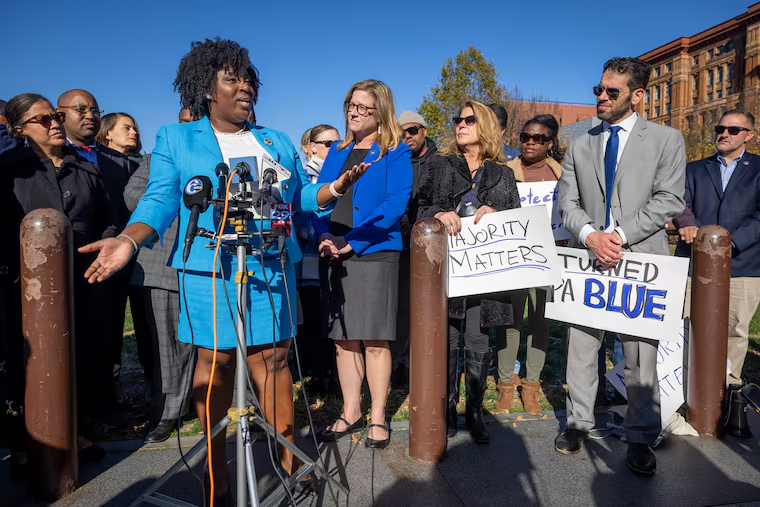The Philly suburbs helped Democrats flip the Pa. House two years ago. Now, some seats aren’t even competitive.
In 2022, a number of tight races put the chamber in Democratic control. This year, many of those contests aren’t competitive.

When Melissa Cerrato learned she had successfully unseated a longtime Republican state representative, it was a week after Election Day and her win came down to just 63 votes.
Cerrato’s highly competitive race in Montgomery County tipped the Pennsylvania state House, allowing Democrats to seize control of the chamber for the first time in more than a decade.
That was just two years ago. Today, Cerrato is running for reelection, and a repeat nail-biter of a race is not expected this time. In fact, her race is hardly competitive. Her Republican challenger doesn’t appear to have a campaign website and hasn’t filed recent fundraising paperwork with the state.
“It’s a very different scenario to be in,” Cerrato said.
Her 151st Legislative District is one of several in the suburbs of Philadelphia that Democrats flipped in 2022 — to unexpectedly take control of the state House — that are nowhere near as competitive this year. It’s an illustration both of Democrats’ growing dominance in much of the collar counties, and of how redrawn legislative districts rendered some areas out of reach for the GOP.
Of the 39 state House districts representing more than 2.3 million Pennsylvanians in the rapidly growing four collar counties around Philadelphia — Montgomery, Chester, Delaware, and Bucks — 31 districts are represented by Democrats. What’s more: Nearly half of them have flipped from Republican to Democratic control since 2018, and as the redrawn districts have grown increasingly blue, many remain uncompetitive today.
Control of the state House remains a toss-up and will come down to about 10 races statewide. Republicans are targeting seats held by vulnerable Democrats in other parts of the state that are leaning redder. Meanwhile, Democrats hope to pick up some of the few remaining GOP-held seats in the collar counties — like Rep. Craig Williams’ seat as the last Republican representing parts of Delco or two Lower Bucks seats represented by Republican Reps. K.C. Tomlinson and Joe Hogan — as ones they think they can flip to maintain and expand their narrow majority.
» READ MORE: These are the Pa. House races to watch in November that will determine who takes or keeps control
“The suburbs offer a huge path forward,” said House Majority Leader Matt Bradford (D., Montgomery) earlier this fall. “The realignment that we’ve seen just since 2018 in the suburbs, a wholesale move from red to blue, is encouraging.”
Only one Democratic state representative in the Philadelphia suburbs is in a highly competitive race: Rep. Brian Munroe, in central Bucks County, where GOP challenger Dan McPhillips has received more than $600,000 in ads from a Jeff Yass-backed political action committee, the Commonwealth Leaders Fund, to try to flip the seat back to red.
Munroe unseated former GOP Rep. Todd Polinchock in 2022 by just a few hundred votes. Republicans have invested big money in McPhillips to win the seat back, as well as on seats in other parts of the state, to flip the narrow statehouse majority back into their control. On Saturday, Gov. Josh Shapiro — who endorsed Munroe and other Democrats in hopes of expanding his party’s majority in the chamber — is expected to rally with Munroe in Warminster.
Bucks County represents an outlier in the increasingly blue Philadelphia suburbs — a politically purple swath where Republicans now have more registered voters than Democrats — and the county boasts a strong GOP and is represented by a Republican in Congress, Rep. Brian Fitzpatrick.
But elsewhere in the Philadelphia collar counties — especially the fast-growing suburbs in Chester, Delaware, and Montgomery Counties that have increasingly helped lift Democrats to statewide victories — the environment has changed.
Even in 2022, the 151st District, which includes Horsham and Upper Dublin, was already a challenge to hold onto for incumbent Rep. Todd Stephens. He was a popular, moderate Republican who before that year had been endorsed by Planned Parenthood twice. But President Joe Biden won the district with 60% of the vote in 2020, making Stephens a prime target for Democrats to pick off.
» READ MORE: ‘City folks’ who moved to Philly’s fast-growing suburbs could help Kamala Harris defeat Donald Trump in Pa.
It’s a similar story in Delaware County’s 168th District that stretches from Radnor to Newtown Square and surrounding areas, which had been held by Republican Chris Quinn and was long controlled by the GOP. But the county was trending toward Democrats for a decade, and the seat was something of a white whale for the party.
Newly redrawn House districts made Quinn’s district bluer in 2022. Democrat Lisa Borowski unseated him, though it wasn’t particularly close. Despite both sides spending big in the area and Quinn having the benefit of incumbency, Borowski won by 12 percentage points.
» READ MORE: Is the new Pa. congressional map better for Democrats or Republicans? We tested it.
Two years later, Borowski is running for reelection and facing Republican challenger Kathryn Buckley, who has struggled with fundraising. Buckley reported raising about $6,000 between May and October, according to a recent campaign-finance filing. Over the same period, Borowski raised $84,000.
Democrats have solidified the Philly suburbs as a stronghold because of the new maps and because of the “changing coalitions” of the two parties: more suburban educated voters joining the Democratic Party, while blue-collar workers concentrated elsewhere shift red, said Harrisburg-based GOP consultant Christopher Nicholas.
Joe Corrigan, a strategist who works with House Democrats, said the trend in some suburban districts is in many ways a reflection of redistricting. Independent analysts said new maps that took effect in 2022 were more evenly split than before, when the districts had favored Republicans.
“Speaker [Joanna] McClinton and leader [Matt] Bradford swung for the fences on the redistricting, and you can see the difference,” he said.